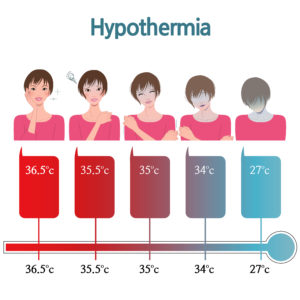
Hypothermia
If you find someone with hypothermia, it is important not to reheat them too rapidly, as this can complicate matters and could even cause cardiac arrest. The mechanism in which the person becomes too cold can vary, but the body needs to be warmed up no matter what. They may have fallen into very cold water, been outside in the freezing cold for too long, or have even lost a lot of blood through a catastrophic bleed. If a person has hypothermia, the ability for their blood to clot will become compromised.
Both damp clothing and water itself can draw heat out of the body 20-25 times faster than air. Therefore it is very important to ensure that the person is out of the water and free of wet clothing. They then need to be dried by patting gently with a towel. Do not rub them as their skin will be very sensitive at this point.
Signs of hypothermia include uncontrollable shivering, disorientation, and confusion. In some cases, the patient can be unresponsive. With severe hypothermia, the pulse can be slow and weak and often difficult to detect. Hypothermia doesn’t just happen to people who are outside in the cold too long. Often people can suffer from hypothermia in their own home. This is often the case with the elderly trying to save money on heating costs.
For more information on training courses, visit our “Courses” page which also includes our First Responder and First Person on Scene (FPOS) Courses.
